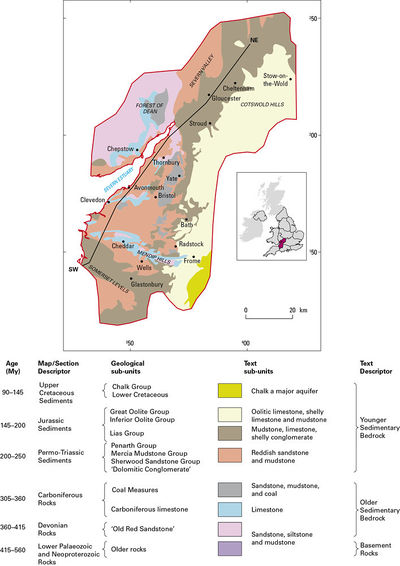Category:16. Bristol and Gloucester district: Difference between revisions
No edit summary |
No edit summary |
||
| (11 intermediate revisions by 2 users not shown) | |||
| Line 1: | Line 1: | ||
This account provides a broad perspective of the geology of the Bristol and Gloucester region, covering | __NOTOC__ | ||
most of Somerset, Bristol, Bath, south Gloucestershire and the Forest of Dean. Figure | [[Image:P902245.jpg|thumb|400px|Geological sketch map and key showing the range and distribution of different rock types in the Bristol and Gloucester region, in relation to the major towns and cities. The extent of the Bristol and Gloucester region is identified on the inset map of the United Kingdom. P902245.]] | ||
geological sketch map and key of this region showing the rock types occurring in relation to the major | This account provides a broad perspective of the geology of the Bristol and Gloucester region, covering most of Somerset, Bristol, Bath, south Gloucestershire and the Forest of Dean. '''Figure P902245''' provides a geological sketch map and key of this region showing the rock types occurring in relation to the major towns and cities. The region is one of the most geologically varied parts of the country, with almost every geological time period represented. This account outlines the geology to a depth of at least a kilometre and summarises the current and historical use of the geological resources in the area. | ||
towns and cities. The region is one of the most geologically varied parts of the country, with almost every | |||
geological time period represented. This account outlines the geology to a depth of at least a kilometre and | |||
summarises the current and historical use of the geological resources in the area. | |||
It is perhaps no coincidence that William Smith, the ‘Father of English Geology’ produced the World’s first | It is perhaps no coincidence that William Smith, the ‘Father of English Geology’ produced the World’s first geological map in this region, based on the country around Bath. The region also hosts some well-known geological sites including Cheddar Gorge, the Bath Hot Springs and the Avon Gorge. Exploitation for mineral resources including lead, zinc, iron, coal and limestone (for aggregate and building stone) has taken place since Roman times. Consequently, there is a long heritage of geological research. The surface geology is reasonably well known, particularly from surface outcrops and especially in coalfield areas where records from coal mines, deep boreholes and exploration surveys provide information on the geology up to 300 m below the surface. Although geophysical seismic surveys, which provide information on the rocks by sending sound waves through the ground, have provided some data, the lack of deep boreholes means much of the geological structure and details of the rocks themselves below this depth remains poorly understood. | ||
geological map in this region, based on the country around Bath. The region also hosts some well known | |||
geological sites including Cheddar Gorge, the Bath Hot Springs and the Avon Gorge. Exploitation for mineral | |||
resources including lead, zinc, iron, coal and limestone (for aggregate and building stone) has taken place | |||
since Roman times. Consequently, there is a long heritage of geological research. The surface geology is | |||
reasonably well known, particularly from surface outcrops and especially in coalfield areas where records | |||
from coal mines, deep boreholes and exploration surveys provide information on the geology up to 300 m | |||
below the surface. Although geophysical seismic surveys which provide information on the rocks by sending | |||
sound waves through the ground have provided some data, the lack of deep boreholes means much of the | |||
geological structure and details of the rocks themselves below this depth remains poorly understood. | |||
[[Category:Regional Geology | 16]] | [[Category:Regional Geology overview | 16]] | ||
[[Category:Geological_regions_of_England | ]] | |||
Latest revision as of 09:40, 19 April 2016

This account provides a broad perspective of the geology of the Bristol and Gloucester region, covering most of Somerset, Bristol, Bath, south Gloucestershire and the Forest of Dean. Figure P902245 provides a geological sketch map and key of this region showing the rock types occurring in relation to the major towns and cities. The region is one of the most geologically varied parts of the country, with almost every geological time period represented. This account outlines the geology to a depth of at least a kilometre and summarises the current and historical use of the geological resources in the area.
It is perhaps no coincidence that William Smith, the ‘Father of English Geology’ produced the World’s first geological map in this region, based on the country around Bath. The region also hosts some well-known geological sites including Cheddar Gorge, the Bath Hot Springs and the Avon Gorge. Exploitation for mineral resources including lead, zinc, iron, coal and limestone (for aggregate and building stone) has taken place since Roman times. Consequently, there is a long heritage of geological research. The surface geology is reasonably well known, particularly from surface outcrops and especially in coalfield areas where records from coal mines, deep boreholes and exploration surveys provide information on the geology up to 300 m below the surface. Although geophysical seismic surveys, which provide information on the rocks by sending sound waves through the ground, have provided some data, the lack of deep boreholes means much of the geological structure and details of the rocks themselves below this depth remains poorly understood.
Subcategories
This category has the following 3 subcategories, out of 3 total.
The number of included categories (C), pages (P) and files (F) is stated in brackets.